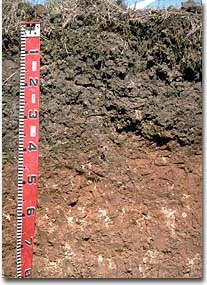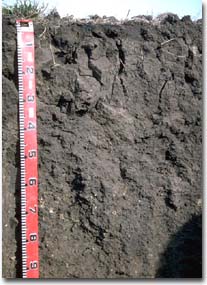Soil Characteristics and Management Options
General Description
The Grey Clay Plains unit represents a depositional area for soil materials and the unit is located low in the landscape as compared to other surrounding units. The soil types and problems associated with management of the soils are strongly influenced by the position in the landscape.
Generally the soils found within this unit represent some of the best soils within the study area for agricultural purposes in average years. In dry years the clay texture of the soil reduces the availability of water to crops and pastures. In wet years, production can suffer from surface water flows (flooding) and increases in groundwater as a result of poor management on surrounding units.
| Surface soil: | Shallow to moderately deep well structured light and medium clays, some self mulching, slightly acid to moderately alkaline pH, non-sodic and low salinity. |
| Subsoil: | Deep structured medium to heavy clays, strongly alkaline pH, sodic and dispersive and generally high salinity. |
Major Limitations
| Soil Problem | Result |
| Surface soil structure. | Decreased water permeability, poor crop/pasture performance. |
| Subsoil alkaline pH. | Reduced rooting depth. |
| Position in landscape. | Flooding. |
Management Suggestions
These are some of the best cropping soils in the area but are at risk from flooding and salinity as a result of poor management of surrounding areas. Although these are good cropping soils, attention needs to be made to minimising cultivation, maintaining groundcover levels and promoting good crop growth through contemporary crop husbandry practices.
| Soil Problem | Management Suggestions |
| Surface soil structure. | Stubble retention, reduced tillage, gypsum*. |
| Subsoil alkaline pH. | No economic management options. |
| Flooding. | Suitable management of other soil units (see recommendations associated with each). |
* Soil tests are recommended prior to investing in gypsum.
Soil Characteristics
Water Infiltration and Permeability
These soils have a high shrink/swell capacity which alters the structure of the soil between the dry and wet phases. When dry, these friable cracking clay soils are usually well structured thus having good aeration and a high permeability to water. Upon wetting, these clays swell reducing the total porosity which reduces aeration and water infiltration. Increased water runoff from surrounding units will place greater pressure on these soils and waterlogging may occur in above average rainfall years. Minimising water runoff from surrounding slopes is critical to optimising production from these soils.
Water Holding Capacity (Soil water storage capacity)
Self-Mulching Grey Vertosols have a high moisture holding capacity that enables crops to finish later in an average year as compared to a sandy soil. However, due to the heavy texture of the clay soils, more early season rainfall is required to instigate crop and pasture growth. This becomes a problem in dry years with the risk of crop failure or low yields increasing.
The good surface structure of the soil allows roots to grow to reasonable depths and therefore exploit moisture at depth. The depth to which plant roots will grow in this soil will be dictated by seasonal conditions. In wetter years, rooting depth will be shallower than drier years. In average years, it is not uncommon to find reasonable amounts of unused available moisture at depth due to roots unable to adequately exploit lower horizons because of physical or chemical constraints such as high pH and/or salinity levels.
Soil Salinity
Both sites assessed in the soil survey showed increasing salinity with soil depth. At depth, the high salt levels may create a barrier to root exploitation. The location of these soils low in the landscape increases the risk of increased soil salinity through discharging saline groundwater. In addition, the low lying nature of these soils in the landscape increases the risk of flooding via overland flow from areas higher in the landscape. Catchment based actions to increase plant water use via trees and the management of crops and pastures to increase plant water use need to be implemented to decrease this risk.
Soil Erosion
Potential for water erosion is low due to the low relief. The potential for wind erosion is moderate when the soil is dry, has less than 30% vegetative cover and is heavily stocked or over cultivated. Maintaining greater than 30% vegetation cover will significantly reduce the risk of wind erosion.
Soil pH
The soil is generally alkaline throughout and increases with soil depth. Although productive agriculture has an acidifying effect on soil, the high soil pH will provide a long term buffer to the effects of acidification. Growing alkaline tolerant crops and pastures is the only management option recommended.
Fertility Status
These soils have moderate to high fertility and have a high capacity to retain nutrients. However, nutrient replacement through fertiliser is required for maintaining productivity. Reduced cultivation and increased vegetation cover will enhance this character through the build-up of organic matter. Recorded low levels of phosphorus, nitrogen and the trace element zinc requires constant monitoring particularly under cropping. The high pH may restrict the availability of some elements to plants, particularly iron, zinc and copper.
Soil Performance Under Management
Response to cultivation (Seed preparation)
The predominate soil within this unit is a self-mulching clay that is friable and easy to work in the dry to moist stage. Self-mulching clays become very sticky when wet. Non-friable clays are also found within this unit and do not show the friable characteristics of the self-mulching clays. Non-friable clays are more difficult to cultivate and can be hardsetting.
These soils have been extensively cropped over the years and have undergone significant cultivation. Soil structure has declined as a result. Reduced tillage techniques improves soil structure and enhances root development, particularly early in the growing season which is important in optimising yield. Improved soil structure will also enable higher water infiltration and therefore reduce runoff.
Tillage or excessive trafficking of clay soils should be avoided if the soil is in a moist to wet condition (i.e. wetter than the plastic limit). At such moisture conditions, tillage or excessive trafficking can result in structural damage (e.g. compaction, smearing) occurring. Ideally, tillage and trafficking should take place when the soil is drier than the plastic limit down to at least the tillage depth.
Plant Establishment (Germination, Emergence)
The self-mulching soils allow for good plant establishment whilst the non-friable or hardsetting surface soils require more considered management with respect to minimum tillage and stubble retention. These management options will improve soil structure and therefore plant establishment on both the self-mulching and non-friable surface soils
Root Development (Limits to depth)
On these clays, deeper root development is often dependent on the climatic conditions and friability of the subsoils. The sodic nature of many of the subsoils indicates a tendency to swell and become tight, restricting root growth as well as reducing moisture and air movement.
High pH levels and high salinity levels restrict deep root development.
In wetter years, rooting depth is often shallower than during drier years due to the easier access to moisture.
Chemical Residues
Agricultural chemicals such as herbicides and pesticides are made inert via four main processes: a) direct binding to soil particles particularly clays and organic matter b) direct binding to surface organic matter such as stubbles c) chemical hydrolysis (chemical breakdown) and d) microbial breakdown. Each of these processes is affected by soil type, soil moisture and temperature, soil pH, organic matter content and microbial activity.
Higher levels of organic matter will increase binding sites for chemicals in the soil, increase the overall microbial activity and increase the breakdown of the chemicals in the soil.
Sulphanyl Urea herbicides will remain active longer in alkaline soils and will be leached with excessive rainfall. As breakdown of the chemical is by microbial activity and acid hydrolysis, little breakdown will occur by acid hydrolysis (due to the alkaline nature of the soil) and therefore microbial breakdown will become the principal form of herbicide degradation.
Imidazolinones are less soluble in alkaline soils and will not be leached to a great depth. Breakdown will be via microbial activity.
Triazines will be fixed onto the alkaline clays and thus more subject to microbial breakdown.
Trifluralin is fixed to the surface soil and is degraded by microbial activity. Lontril is fixed onto and persists on stubble material.
Management
These are generally good cropping soils where the surface soil is self mulching and the subsoils are not excessively saline. Due to the soils being located low in the landscape, risks of crop loss through waterlogging or flooding in years of above average rainfall is high. Appropriate management of other areas in the catchment need to be considered for longer term production for these soils in order to minimise overland water flows and increasing groundwater levels.
The soil structure is improved by maintaining vegetation cover and optimising crop and pasture growth to increase organic matter. The generally good structure of these soils can be reduced by excessive cultivation or poor timing of operations. Cultivation of these soils when either too wet or too dry will destroy this structure, increasing the soils tendency to disperse and crust. Cultivation also speeds up the degradation process of organic matter in the soil.
Tillage of cracking clay soils should be avoided if the soil is wet (i.e. wetter than the plastic limit). At such moisture conditions, tillage or excessive trafficking or overstocking could result in structural damage (e.g. compaction, smearing) occurring. Ideally, tillage and trafficking should take place when the soil is drier than the plastic limit, down to at least the tillage depth.
 | Compaction in Vertosols The Grey Vertosol on the left occurs in an undisturbed roadside reserve. Note the strongly developed peds occurring in the upper subsoil (10-30 cm zone). The Grey Vertosol on the right occurs in a cultivated paddock near Diapur. Note that the 10-30 cm zone has become compacted and the natural aggregates have been lost. This compacted zone will significantly restrict root and air movement in the subsoil. |  |
Best management cropping practices such as crop rotation, minimisation of fallows, minimum tillage, stubble retention and considered fertiliser programs should be utilised to promote the best crops from these soils in most years.
Lucerne can be grown instead of medic clovers providing higher and more regular production. Lucerne often responds to summer and autumn rainfall that falls outside the growing season for medics.
Implications for Revegetation
These surface soils will allow good seedling emergence. They are usually free draining and are not likely to be prone to waterlogging. Revegetation, either by direct seeding or transplanting container plants, will achieve best results after the autumn break. This will ensure good root development over the following spring and increase the chance of survival over summer.
Current Practices
These soils are intensively cropped in rotations, often fallowed and sown to wheat, followed by barley or sometimes oats. Legume crops (field peas, faba beans and chickpeas) are used to supplement soil nitrogen. Other crops such as canola, safflower and sunflowers are also grown.
Where livestock (mainly sheep) are included as a farming enterprise, legume crops may be replaced by medic clovers for grazing.


